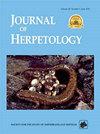黄昏蝾螈的体型和周期
IF 0.8
4区 生物学
Q3 ZOOLOGY
引用次数: 2
摘要
摘要平等适应度范式(EFP)是一种生活史模型,其中适应度的货币是可用的能量,而不是个人,主要的权衡是生存(评估为世代时间)和生产力(评估为生长和繁殖率)之间的权衡。在目前的研究中,我在EFP的框架内研究了Desmognathus属蝾螈的世代时间、首次繁殖年龄、生产力和死亡率的变化。Desmognathus蝾螈仅限于北美洲东部,分布中心在阿巴拉契亚山脉南部。本报告的数据来源是已发表的五种Desmognathus的生活史和人口统计研究,其中包括该属最小和最大的成员。分析表明,与同等大小脊椎动物的EFP标度函数预测的相比,德氏蝾螈首次繁殖时的年龄更大,繁殖时间更长,生产力更低,死亡率更低。物种之间在这些参数上的差异与成虫体型的变化以及体型与该属栖息地利用率之间的关联有关,其中最大的物种是山溪中的水生物种,最小的物种是中亚热带森林中的陆生物种。中等大小的河岸物种比溪流和森林栖息地更广泛,分布也更广泛。Desmognathus的河岸生活模式很可能代表了一种促进扩散的适应。该属的适应性辐射表现为极端的生活史和通过首次繁殖和世代时间的年龄变化介导的体型多样化。本文章由计算机程序翻译,如有差异,请以英文原文为准。
Size and Cycle in Dusky Salamanders
Abstract. The equal fitness paradigm (EFP) is a life-history model in which the currency of fitness is usable energy rather than individuals, and the principal trade-off is between survival, evaluated as generation time, and productivity, evaluated as growth and reproductive rates. In the current study I examined variation in generation time, age at first reproduction, productivity, and mortality in salamanders of the genus Desmognathus within the framework of the EFP. Desmognathus salamanders are restricted to eastern North America, with a center of distribution in the southern Appalachian Mountains. The data sources of the present report are published studies of life histories and demographics of five species of Desmognathus that include the smallest and largest members of the genus. The analysis showed that Desmognathus salamanders have greater ages at first reproduction, lengthier generation times, lower productivities, and lower mortality rates than are predicted by the scaling functions of the EFP for vertebrates of equivalent sizes. The differences among species in these parameters are correlated with variation in adult body size and the association between body size and habitat utilization in the genus, wherein the largest species are aquatic in mountain streams and the smallest are terrestrial in mesic forests. Streamside species of intermediate size exploit a broader range of habitats and are more widely distributed than the stream- and forest-dwelling forms. It is likely that the streamside mode of life in Desmognathus represents an adaptation promoting dispersal. Adaptive radiation in the genus is expressed in extreme life-history and body-size diversification mediated through variation in age at first reproduction and generation time.
求助全文
通过发布文献求助,成功后即可免费获取论文全文。
去求助
来源期刊

Journal of Herpetology
生物-动物学
CiteScore
1.60
自引率
0.00%
发文量
45
审稿时长
6 months
期刊介绍:
The Journal of Herpetology accepts manuscripts on all aspects on the biology of amphibians and reptiles including their behavior, conservation, ecology, morphology, physiology, and systematics, as well as herpetological education. We encourage authors to submit manuscripts that are data-driven and rigorous tests of hypotheses, or provide thorough descriptions of novel taxa (living or fossil). Topics may address theoretical issues in a thoughtful, quantitative way. Reviews and policy papers that provide new insight on the herpetological sciences are also welcome, but they must be more than simple literature reviews. These papers must have a central focus that propose a new argument for understanding a concept or a new approach for answering a question or solving a problem. Focus sections that combine papers on related topics are normally determined by the Editors. Publication in the Long-Term Perspectives section is by invitation only. Papers on captive breeding, new techniques or sampling methods, anecdotal or isolated natural history observations, geographic range extensions, and essays should be submitted to our sister journal, Herpetological Review.
 求助内容:
求助内容: 应助结果提醒方式:
应助结果提醒方式:


